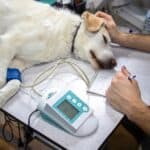
Today we are going to tell you about the most common diseases in rabbits. Although rabbits are a small animal that responds very well to all kinds of care, it should not be ignored that it is exposed to some health problems that can put its life at risk. If you want to enjoy the maximum of years with your little furry with long ears, keep reading this new article and get the necessary information about the most common problems and diseases of rabbits as well as their symptoms.
Types of diseases in rabbits
Some of the causes for which certain diseases of rabbits appear are a poor diet or food in poor condition, an inadequate cage, poorly healed wounds, improper hygiene, stress or excessive temperatures. Others can be prevented through vaccination.
Most common diseases in rabbits of viral origin
Myxomatosis:
A serious, contagious and fatal disease that is prevented through annual vaccination. Your bunny will have symptoms such as poor appetite, decay, swelling in the face and other parts of the body. There is no treatment to treat it, causing death in less than a month. Prevention is the best and only way to protect our little dog. The vectors or transmitters of the virus that causes this disease are blood- sucking insects, that is, they feed on blood, such as mosquitoes, some flies, ticks, fleas, lice, etc. In addition, it can also be spread by contact with other animals that are already sick. Rabbits that have this disease usually die between the second and fourth week after infection.
Hemorrhagic fever:
Very aggressive virus that causes seizures and nosebleeds that end up causing death in less than 3 days. Some of its symptoms are anorexia, apathy, nervous signs and respiratory problems. It is prevented with a correct vaccination system.
Rage :
Although it is practically eradicated in some areas, outbreaks of this disease still occur. There is no cure and the way to avoid contagion is through annual vaccination. If we try to have the vaccination of our rabbit up to date, while avoiding possible contacts with other animals that seem to be ill with rabies, we can be calm.
Viral hemorrhagic disease (RHDV):
It is a disease caused by a Calicivirus type virus that affects wild and domestic rabbits. The symptoms are very varied. The main organ that it affects is the liver, but the most frequent is a generalized hemorrhagic type of affectation due to liver damage, although there may also be bloody nasal discharge, ocular and even neurological signs. The most acute pictures pass in a matter of hours, they can even happen sudden deaths. The disease is transmitted through feces, urine, tears, saliva, etc., from infected animals, as well as through insects and even through our clothing.
Unfortunately, if our bunny contracts the disease, little can be done since it is fatal, there is no specific treatment, although there is a vaccine to prevent it.
Diseases in rabbits of bacterial and fungal origin
Pasterellosis:
This disease is of bacterial origin and can be caused by two different types of bacteria, by pasteurella and by bordetella. It usually occurs due to the environment, the climate, the dust raised by dry food and accumulated stress. The rabbit will suffer from symptoms such as sneezing, snoring and runny nose. It can be treated with specific antibiotics which will be very effective if the disease is not very advanced.
Pneumonia:
In this case the symptoms are also respiratory so sneezing, runny nose, snoring, coughing will occur. It is much more dangerous and complicated, since it reaches the lungs and makes breathing difficult. Its treatment is also with antibiotics.
Otitis and other ear diseases :
It is usually identified by a tilted head and loss of balance. It affects first the middle ear and then the inner ear, causing inflammation, itching and pain. It must be detected in time to treat it with an antibiotic and anti-inflammatory. These symptoms usually manifest when the disease is advanced, so we usually realize it late and therefore almost no treatment is usually effective.
Tularemia :
It is one of the diseases of rabbits classified as very serious because it does not present symptoms and can only be detected by laboratory tests. The animal stops eating and, if it is not detected in time, by not feeding they can die in 3-4 days. Tularemia is related to fleas and mites.
Conjunctivitis and eye infections:
They are produced by bacteria on the eyelids of rabbits. The eyes become inflamed and abundant ocular discharge occurs. In addition, in more serious cases, eventually the hair around the eyes is glued, the eyes fill with blemishes and secretions that prevent the animal from opening its eyes and there may even be pus. Conjunctivitis can be of non-bacterial origin, being the cause of irritation produced by different allergens such as household dust, tobacco smoke or dust that can be produced in your bed if it contains highly volatile particles such as sawdust. We must apply specific eye drops prescribed by our trusted veterinarian for the time indicated.
Coccidiosis :
Coccidia are microorganisms that attack the rabbit’s stomach when it has low defenses or has a high level of stress. Some of the symptoms are hair loss and continuous and excessive gas and diarrhea; the animal stops eating and drinking and ends up dying. It is one of the diseases of rabbits that produces the highest mortality.
Rabbit ringworm:
It is produced by a fungus that affects the skin of rabbits. It reproduces at high speed by spores, so if it manifests itself, it is difficult to control the contagion to other individuals who live together. There are hairless areas that are rounded and crusted on the skin, especially on the animal’s face.
Mastitis :
Infection in the breasts that causes fever and swelling. It is treated with antibiotics.
Rabbit diseases caused by parasites:
Parasitic rabbit diseases can be internal or external.
Scabies:
Mange is produced by mites that tunnel into the various layers of the skin, even reaching the muscles, of the infested animal. There they reproduce and lay their eggs from which, when they hatch, the new mites that produce more itching, wounds, scabs, etc. come out. In the case of rabbits there are two types of scabies, the one that affects the skin of the body in general and the one that only affects the ears and ears. Scabies is very contagious between rabbits and is caused by contact with already infested animals. It is prevented and treated with ivermectin.
Fleas and lice :
Very common in rabbits that live with dogs, cats or that usually go outside. The rabbit scratches excessively due to itching. We must be careful and prevent this by deworming our furry since, although it is not a complicated disease, parasites can transmit dangerous diseases such as myxomatosis and tularemia. Its origin is external. We must avoid it by deworming mainly our pets that can have them more easily such as cats and dogs, and we must also use a specific antiparasitic for rabbits that our veterinarian indicates.
Diarrhea :
It is usually due to an inadequate diet. Sudden changes in diet and not washing fresh food before feeding are the most common causes. The digestive system of rabbits is very sensitive to changes, so we must always do them gradually. The biggest problem with diarrhea is that the rabbit feels down, loses its appetite and becomes dehydrated very quickly.
Coliform infection :
This infection is a secondary infection by opportunistic parasites. When our rabbit already suffers, for example, coccidiosis, this disease causes secondary infections to easily occur. Coliform infection in rabbits is caused by Escherichia coli and the main symptom and most serious problem that it produces is continuous diarrhea and if it is not treated in time with injectable enrofloxacin or diluted in the water that the rabbit drinks, it can end up producing the death of the animal.
Worm :
This disease is common in many animals. It occurs when the larvae of flies that have laid their eggs in a wound of the pet, begin to feed on a wound, it can cause death after a state of shock.
Hereditary diseases:
Tooth overgrowth or shortening malformation of the upper and / or lower jaw:
It is a hereditary problem that occurs due to excessive growth of the teeth, either the upper or lower incisors, which ends up moving the jaw or maxilla backwards due to space problems.
Common health problems in rabbits:
Although we do not classify them within the diseases of rabbits as such, the following health problems are very common in the species and we must also pay attention to them:
Stress:
Stress in rabbits can be caused by several factors. For example, due to the fact of feeling very lonely or due to the lack of affection, through changes in their environment and changes of home and other animals with which they live. Also, of course, not having enough space to live, a poor diet and little exercise will produce stress. Try as much as possible to dedicate time and entertainment to avoid it, as well as a cage appropriate to its size where it can move freely.
Flu or cold :
Colds are one of the most common rabbit illnesses when there is too much humidity or direct drafts. It is very common to happen when they have low defenses and it occurs with sneezing, watery eyes and nasal secretions.
Inflammations and suppurative wounds of the skin:
It is easy that living in a cage, even for a few hours of the day, we sometimes see that our rabbit has an inflamed area or even a wound. These wounds tend to become infected quickly.
Inward folded eyelids:
Known as invagination of the eyelids or entropion, it produces irritation and suppuration in the tear duct. If it is not treated, it can become infected and cause blindness.
Hair loss and ingestion of it:
Hair loss in rabbits usually occurs due to stress and lack of some nutrients and vitamins in their daily diet. For these same reasons, they often eat their hair that falls out. Therefore, if we detect that this happens to our little one, we should go to the vet to check what may be wrong in his diet or what may be stressing him and thus be able to rectify the problem.
Obesity:
Obesity is one of the most frequent diseases of rabbits due to the amount of food they eat and the lack of daily exercise. Provide your rabbit with a suitable and quality diet .
Reddish urine:
It is a deficit in the feeding of the rabbit that causes this color in the urine. We must review their diet and balance it. We should not confuse reddish urine with bloody urine since bloody urine is a much more serious problem.
Cancer :
The best way to avoid this health problem is sterilization. Cancer is one of the most common diseases in rabbits, especially in the case of females. Non-operated rabbits have an 85% chance of developing uterine and ovarian cancer, increasing the risk to 96% after 5 years. In addition to avoiding this dangerous disease, you will improve their quality of life, avoid pregnancies and reduce destructive behaviours or markings.
Hairballs in the stomach :
Rabbits groom themselves by licking their hair and ingesting it. This can cause a blockage due to the hairballs not being digested. A diet high in fiber and with a lot of hay, in addition to brushing them regularly to remove loose hair, is the solution.
Heatstroke:
Rabbits handle cold better than heat. This is why some breeds of rabbits withstand temperatures of up to -10ºC well if they have any shelter, but for them the temperatures that are around or exceed 30ºC are too high and if they are exposed to them without water and without a cooler place of refuge to To be able to regulate the temperature, they will suffer a heat stroke with great ease, dying in a short time from cardiac arrest.
They may die of dehydration, but cardiac arrest will likely overtake them sooner. The easiest symptoms to see are the continuous panting and that the rabbit stretches its four legs leaving the belly in contact with the ground looking for a bit of freshness. What we must do when detecting this behavior is to lower the temperature of our rabbit by taking it to a cooler and more ventilated area and we will apply a little cool water on the head and in the armpits, while we try to cool the area of the house in the that the rabbit is found by the time we return it to its home.
Giardisis :
Rabbits, especially the smallest ones, if they present abnormalities in the stool, dehydration, body temperature that is too low or an unusual mood, it may be due to this intestinal infection, which must be cared for quickly and aggressively and with nutritional support. for the animal.
Symptoms of a sick rabbit
If you observe strange behavior in your rabbit or any change in its body, pay special attention to the symptoms to diagnose possible health problems or diseases. Some of the symptoms that can indicate that a rabbit is sick are:
- You eat less or have trouble eating.
- It is thinner.
- You have hair loss or bald spots that are not related to shedding.
- Lumps on the skin.
- Inflammation in the breasts.
- Diarrhea or excessively loose stools that persist over time.
- Snoring, sneezing, coughing, snot, or shortness of breath.
- Watery, red, or irritated eyes.
- Head tilted to one side.
Take care of your rabbit and observe its behaviour and symptoms every day to diagnose any disease as soon as possible and be able to act in time. We recommend that you always have a first aid kit for rabbits on hand, which will help you in an emergency.






